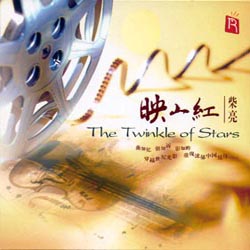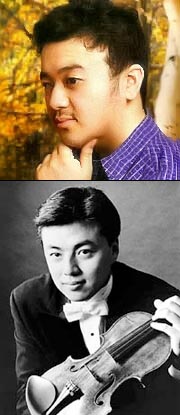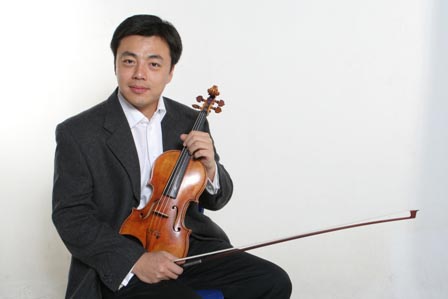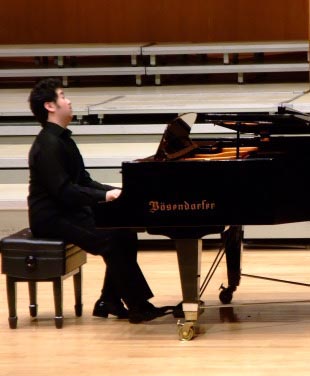 |
||||||||||
 |
||||||||||
 |
||||||||||
Album Title: The Twinkle of Stars Performers: Chai Liang, violin/Dai Bo, piano/Zhang Qiang, pipa/Zhao Jiazhen, guqin/Chen Yue, di/Cao Xiaoqing, accordeon Label and #: BlueSkymusic, Rhymoi Music 1016 Running time: 55'37" Recorded: 2007 Liner notes: Detailed notes in Chinese and English When cinema movies caught on as the new mass medium, film music became a novel art form for classical Soviet composers like Prokofiev, Shostakovich and Khachaturian. Despite the political agenda of the Soviet movies, Western audience have been enjoying their music ever since up to the present days with Schnittke, Artemyev and Gubaidulina. (Come to think of it, propagandism exists in many forms, even in Hollywood.) What happened in China from the 1950s to the new millennium was not much different except the composers and their works never quite reached the |
||||||||||
 |
||||||||||
|
international musical stage. This vast land where Western music was once oppressed and musicians persecuted, now flourishes with violinists, pianists and other Western instrumentalists and vocalists that have taken the world by storm. A popular joke even goes as far as saying that if you see on the street in a Chinese city a young person not carrying a violin case, it is because he or she is learning the piano. |
||||||||||
 |
Dai Bo is pianist, accompanist, chamber musician and award-winning arranger/orchestrator. His arrangements cover Chinese and Western movie themes, pop music and Piazzolla. There has been very little written about him. As he mentions in his blog, he did a few interviews but nothing was published because he always finds other people's perspective of him not true to his self [source]. To watch a video of Chai and Dai, go to Dai's blog, scroll down to the middle and click on the 'play' button of the TV screen in the left column. Like their Soviet counterparts, Chinese movies from the 50s to the 70s were very much dominated by political propaganda. Five of the twelve titles on this CD belong to that era and many of these movie themes have long become part of the classical repertoire. When transcribed for violin and piano, the classical beauty and compositional aesthetics are abounty. "Why are the Flowers so Red" and "Party at Aobao" are two colorful pieces with pungent folk music overtones, the former being Tadjik (Xinjiang province) and the latter Mongolian. Both have earned their places in concert halls as encore favourites. The Twinkle of Stars was the first children's movie in the 70s. The title theme depicts the little orphaned hero who vowed to serve his country. Piano accompaniment is partnered with the rustic bamboo reed di, forming an unusual pastoral trio. Plum Blossoms is from the 1978 movie that was based on an opera created during the Cultural Revolution. Centered around the heroine who participated in the communist movement striving for victory, the music is surprisingly lyrical. Waves of the Honghu Lake is from a movie of the early 60s that tells of the courageous struggle of the Red Guards. On violin and piano, this piece comes through as unassumingly poetic and warm. |
|||||||||
| Moviegoers of the 90s will remember the sentimental theme from Endless Love (1995), a remake of the Hong Kong all-time classic and modern-time La Traviata of the 60s. Of contrasting rhythm and mood is "Duel" from the 2004 movie A World Without Thieves where the violin and the piano assume the roles of combating rivals in a final showdown between the good and the bad thief, a melodious and virtuoso showpiece set against pulsating Tadjik rhythm. By the way, it's a must-see movie and a successful collaboration of Chinese and Hong Kong film professionals. Pipa joins the violin-piano duo in "The Tune of the Shepherd", a peaceful and lyrical interlude from the kung fu movie Shaolin Temple (1979), the first blockbuster by Jet Li. |
 |
|||||||||
Another piece with nostalgic beauty is "The Sea is My Home" from the 1982 movie The Sea is calling. The arpreggio pattern on the piano is a simple and effective seascape painting that never fails to move the audience. Accordion adds the dance-hall feel of old Shanghai in the 30s to "Fragrant Roses" from the movie Red Rose, White Rose based on Eileen Chang's daring novel about lust and seduction, he same novelist behind the Ang Lee movie Lust|Caution. The mood is undeniably Piazzolla. The theme from the 1980's movie My Love, a story about a patriotic general and a famous courtesan during the chaotic warlord concession time in thepost Qing dynasty, is characterized by the inclusion of the traditional instrument guqin , an instrument of classic beauty that befits the female leading role. The last track Butterfly Lovers is the scaled-down version of the famous violin concerto. It's the first time I heard the piece in a violin-piano duet. All transcriptions of the tracks were skillfully accomplished by pianist Dai Bo. The partnership of Chai and Dai is commendable for their effortless artistry and musicianship. One thing I like about them is their relaxed but sincere music making. It is without the slightest trace of exaggeration or sentimental overdose. The tonal balance between the two instruments (and other traditional instruments) is always well-proportioned and natural. |
||||||||||
 |
||||||||||
| Post-production was undertaken at Stockfisch Records, Germany. Audiophile-grade sonics make this collection a most welcome addition to the violin category. | ||||||||||
 |
||||||||||
 |
||||||||||